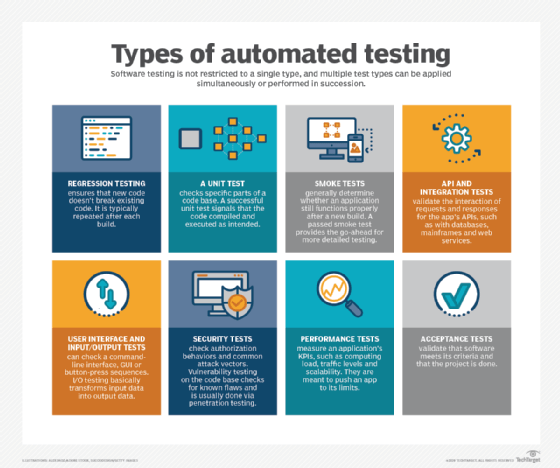From Guidebook to Automated Screening: A Comprehensive Guide to Transitioning Efficiently and Successfully
In the realm of software program screening, the change from manual to automated procedures has become an increasingly important shift for organizations seeking to improve effectiveness and accuracy in their testing techniques. As technology remains to development, the demand for reliable and seamless automatic testing techniques has never ever been much more pressing. The trip from manual to automated testing is not without its challenges, however when come close to strategically and with a clear strategy in mind, the advantages can be considerable - automation testing. In this detailed guide, we will discover crucial steps and factors to consider crucial for an effective transition, from the first choice of tools to the assimilation of automation into existing workflows. Remain tuned to uncover the understandings that will aid lead the way for a smoother and extra efficient screening process.
Benefits of Automated Examining
Automated testing offers many advantages, improving efficiency and precision in software growth processes. One main benefit is the considerable decrease in testing time. Automated tests can be run simultaneously on several tools and running systems, dramatically speeding up the testing stage contrasted to hand-operated testing. This boosted performance enables faster feedback on the high quality of the software program, enabling designers to recognize and address problems immediately.
In addition, automated screening makes certain a greater level of accuracy in finding issues. Since automated tests follow predefined manuscripts, human mistake is decreased, leading to even more trustworthy examination outcomes. Uniformity in screening is likewise enhanced, as automated examinations carry out the very same actions exactly each time they are run. This uniformity is vital in making sure that all capabilities of the software application are completely checked, lowering the chance of unnoticed insects slipping through to manufacturing.
Picking the Right Devices

Firstly, evaluate your objectives and needs. Recognize the extent of your job, the innovations involved, and the ability of your group. This analysis will help you determine the abilities and functions you require in your screening devices.
Secondly, consider the compatibility of the devices with your existing processes and systems. Seamless integration with your existing software application advancement lifecycle is important to ensure a smooth change to automation.
In addition, assess the scalability and flexibility of the devices. As your testing needs progress, the tools should have the ability to adapt and accommodate changes properly.
Finally, element in the assistance and neighborhood around the tools. Durable support and an energetic user community can give important resources and aid when executing automated screening. By carefully considering these facets, you can choose the right devices that line up with your demands and set the stage for a successful change to try this web-site automated testing.
Creating Effective Examination Scripts

When crafting examination scripts, it is vital to take into consideration the certain requirements of the software being checked and guarantee that the manuscripts address all essential performances. Descriptive and clear calling conventions for test manuscripts and examination cases can boost readability and maintainability. Additionally, including mistake handling systems within the examination manuscripts can help in recognizing and dealing with concerns promptly.
Additionally, arranging examination scripts into modular elements can boost reusability and scalability, reducing redundancy and improving performance in examination manuscript upkeep. Regular evaluations and updates to check manuscripts are crucial to equal advancing software application demands and capabilities. By following these principles, testers can create efficient and durable examination manuscripts that add considerably to the success of automated screening procedures.
Integrating Automation Into Workflows
Effective assimilation of automation devices right into existing workflows improves processes and improves performance within software program growth cycles. When incorporating automation into workflows, it is essential to determine repeated tasks that can be automated to save time and minimize human mistake. By flawlessly incorporating automated screening devices like Selenium or Appium right into the software program development lifecycle, teams can achieve faster feedback on code changes, leading to quicker bug discovery and resolution. This assimilation enables continual screening throughout the growth procedure, making certain that any kind of concerns are identified at an early stage, resulting in greater software program top quality. In addition, useful site automation can be utilized to set off tests automatically after each code devote, supplying prompt recognition and maximizing testers to concentrate on more complicated situations. Proper integration of automation tools calls for cooperation in between advancement, testing, and operations groups to establish a unified process that enhances efficiency and effectiveness in supplying high-grade software.
Making Sure a Smooth Change
Successfully transitioning to automated screening entails careful planning and cautious implementation to reduce disturbances and maximize effectiveness in the software application development process - automation testing. To make certain a smooth transition, it is necessary to begin by carrying out an extensive analysis of the existing screening processes and determining locations where automation can bring one of the most significant benefits. Involving with all stakeholders beforehand in the process, consisting of programmers, testers, and task managers, is important for gathering assistance and buy-in for the automation campaign
Interaction is key during this shift phase. Clear communication of the objectives, advantages, and assumptions of automated testing assists to handle any kind of resistance or concerns that may arise. Additionally, providing adequate training and sources for employee to upskill in automation devices and strategies is crucial for ensuring an effective shift.

Conclusion
To conclude, transitioning from guidebook to automated screening supplies numerous benefits, including increased efficiency and reliability. By choosing the suitable tools, composing efficient test scripts, and integrating automation perfectly into workflows, organizations can guarantee a smooth and successful transition. It is vital to embrace automation as an important possession in software application testing processes to improve overall top quality and performance.
In the world of software application testing, the shift from guidebook to automated procedures has actually ended up being a progressively important transition for organizations looking for to boost performance and accuracy in their testing techniques. Automated examinations can be run all at once on several devices and operating systems, significantly speeding up the testing phase compared to manual screening. Uniformity in screening is also improved, as automated examinations carry out the same actions exactly each time they are run.To guarantee the effective application of chosen testing devices, the click over here now creation of reliable test scripts plays a crucial duty in verifying the functionality and efficiency of automated processes - automation testing. By following these concepts, testers can produce efficient and robust examination manuscripts that contribute dramatically to the success of automated testing procedures